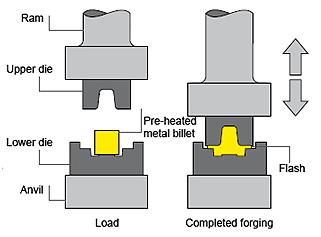Drop forgings are a type of forging process used to manufacture metal parts with high strength and durability. In this process, a piece of metal is heated until it becomes pliable and then placed on a die, a tool with a specific shape and size. The metal is then shaped by the application of force, typically using a hammer or press, which causes the metal to flow into the die, taking on its shape.
Drop forgings are called so because the metal is dropped onto the die from a height, using a drop hammer or a hydraulic press. This produces a uniform and dense structure in the metal, making it stronger and more durable than other types of manufacturing processes. The final product can be a wide range of shapes, including gears, shafts, flanges, and many more.
Drop forgings are widely used in various industries, including automotive, aerospace, construction, and manufacturing. They offer several advantages over other types of manufacturing processes, such as excellent strength-to-weight ratio, improved fatigue resistance, and greater accuracy in size and shape.
Types of Drop Forgings
There are several drop forgings, each with unique characteristics and applications. Here are some of the most common types of drop forgings:
Closed die forging: This is a forging process where the metal is heated and then placed into a die, which is then closed and hammered into the desired shape.
Open die forging: In this process, the metal is heated and placed between two flat dies, which are then hammered or pressed to shape the metal.
Upset forging: Upset forging is a process that is used to increase the diameter or thickness of a metal part by compressing it using a die.
Press forging: This is a forging process where a hydraulic or mechanical press is used to shape the metal.
Drop hammer forging: In this process, a heavy hammer is dropped onto the metal to shape it.
Roll forging: Roll forging is a process where the metal is passed through a series of rollers to shape it.
Each of these drop forgings has advantages and is best suited for specific applications.
Key Advantages of Drop Forging
Drop forging produces high grain flow that makes the metal parts strong and durable.
Drop forging is comparatively a faster process when you compare this process with casting or machining.
It reduces internal defects and porosity to a great extent which helps in designing a strong metal part.
As the metal is fully used up in the die cavity the wastage is minimized in this process.
Due to the numerous advantages of this metalworking method, drop forging has been practiced with hot metals for thousands of years. In fact, drop forging is the most traditional method of manufacturing metal parts. Because of the dependable quality and robustness of the parts or components produced, drop forging has grown to be a highly regarded manufacturing process. Even today, drop forgings are used for manufacturing quality metal parts.


